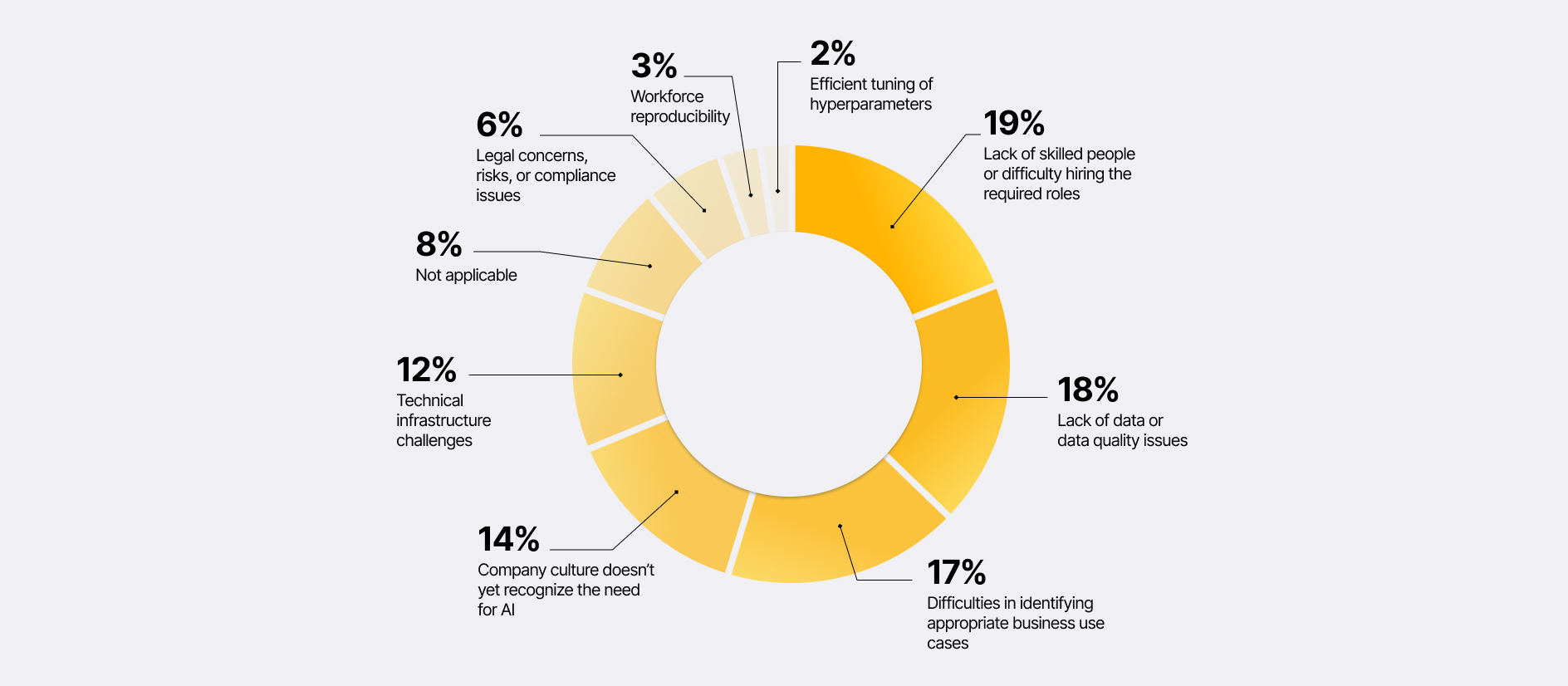In 2022 executives continue to focus on creating data-driven organizations and establish AI-driven culture managing data as a business asset. However, most companies have come a long way in the development of working AI adoption practices that allow bringing value to businesses on everyday basis.
Together with our Computer Vision experts, we gathered information about the most frequent bottlenecks of AI adoption and best practices to manage adoption risks based on recent researches and our experience.
Barriers to ai adoption
Barriers to AI adoption include lack of understanding, data quality and availability, ethical concerns, initial investment costs, and organizational resistance to change. Overcoming these hurdles is crucial for reaping AI’s benefits.
Getting over main AI adoption challenges: best practices
According to the recent survey by O’Reilly, more than half of the challenges connected with applying the Computer Vision and AI services refer to lack of skills, lack of data, or identification of appropriate use cases.

Are these challenges worth worrying about and how can you effectively manage potential risks while starting the digital transformation and AI adoption process? Let’s take a look at the most common challenges and figure out how to stop being afraid of AI adoption and take action:
- Skills shortage
A lack of talent that can ensure a seamless digital transformation process is a frequent blocker in the early stages of AI adoption. Hiring experienced AI professionals can be challenging and expensive for organizations making them hesitatant about prioritizing the need for AI technology in their business strategies. Researches show that the biggest skill gap is ML modelers and data scientists, while the need for specialists responsible for managing computing infrastructure is comparatively low. It is worth saying that we can see that business people often have difficulties in understanding AI stakeholders’ roles that can lead to the need for hiring versatile specialists: it is not the best way forward.The best solution will be to understand and isolate required skills before hiring or find an expert partner providing a complete team of specialists at every stage of your transformation journey. In this case, you can better understand the adoption process, ensure the right prioritization of tasks, and stay focused on your core business goals. Decision-makers also often worry about the skills gap of their current teams and their ability to operate AI solutions effectively.If you want to make business transformation seamless, you should prioritize budgets allocated for team training and establish a culture of continuous expansion of knowledge, skills, and expertise within the organization. - Lack of quality data
Successful implementation of AI models needs quality data to train and therefore provide accurate outcomes. Open-source datasets can be enough for testing ideas and creating MVPs, but fully-featured solutions require clean data to help organizations fully achieve their strategic goals.Some industries may face the challenge of finding the right visuals for model training due to data privacy issues or data inaccessibility. For example, in the Healthcare industry, collecting relevant visuals can be challenging due to the security of sensitive personal information. Make sure you clearly understand all compliance and security issues at the planning stage: this way, you can reduce risks and come to the model training fully prepared.Consider such practices as manual tagging and labeling, randomization, or creating synthetic data. The last one refers to programming-generated visuals focused on your specific needs. You should also pay attention to setting data management processes within your organization at the early stages to avoid problems with enhancing the existing datasets and retraining AI models in the future. - Company culture reluctance
Any transformation is connected with altering habitual processes, additional expenses, and disruption. Sometimes, AI initiatives can find that their company culture doesn’t yet recognize the need for AI. It can be connected with the explainability problem that refers to the ability to explain how AI data-driven decision-making works.If you are reporting to senior decision-makers and want to convey that transformation is worth it and implementation of AI-driven solutions is justified, you need strong arguments based on facts. Educate your boards and senior managers to raise awareness of how businesses can benefit from AI technologies: focus primarily on advantages, not on technical stuff. It can be a long way, but it is definitely worth it.
Among other adoption challenges, we can also see financial risks, technical infrastructure challenges, data security issues, ethical concerns, and lack of strategic approach. Experts also note that companies making progress on their digital journeys are more likely to succeed in delivering value from implementing AI solutions.
Launching the process of transformation helps companies to focus on change management rather than on technology alone and therefore drive quality AI outcomes at scale. So, every step you make towards digital transformation can reduce the potential risks and open for you new opportunities for easier AI adoption.
Reduce risks and share your AI adoption journey with a reliable partner
We can help you make your AI adoption journey straightforward whether you sell consumer goods, develop personal care plans, or run an agriculture business. Contact us to evaluate your readiness for implementing AI and CV capabilities into your business processes and discuss your automation idea in detail.






